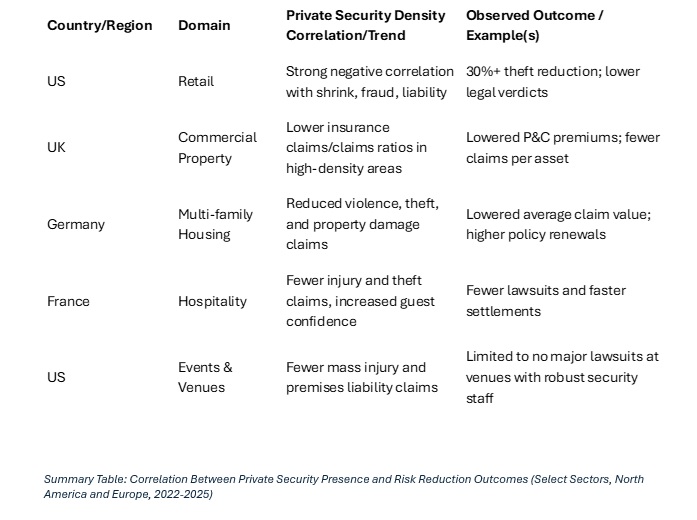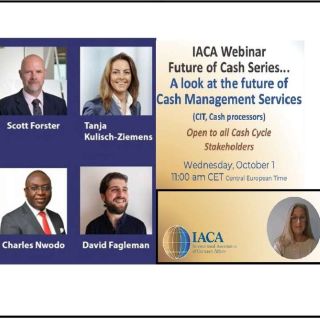
In Part I of our research into correlations between the presence of private security officers and tangible benefits in public and business safety, we uncovered unambiguous evidence linking proactive security investment with lower insurance premiums, less frequent and lower value insurance claims, and a marked reduction in legal claims and settlements. Data makes a clear case for proactively investing in a strong security presence, as the cost of negligence or under-investment has become demonstrably higher than the price tag of on-going risk mitigation.
Below, in Part II, we examine correlations between the density and quality of a private security presence and embezzlement, theft, and other quantifiable risk indicators. Results tell a similar story: organizations enjoy a significant payoff when they make adequate investments in security personnel and systems.
Key Points
- Higher density and quality of security personnel—especially when combined with surveillance and controls—significantly reduce embezzlement, workplace theft, and related losses.
- Causation is most clearly evidenced in industries with significant security risk exposure, including retail, hospitality, healthcare, and event sectors.
- Benefits are strongest for adequately staffed, well trained officers integrated into multilayered security ecosystems; poorly trained or insufficiently deployed officers often fail to reduce risk and may even increase liability.
Preventing Internal Fraud
There is a wealth of data points indicating a positive return on investment for business spedning on security, including:
- Fraud cases are expensive. The Association of Certified Fraud Examiners estimates global median losses from occupational fraud and embezzlement to be $125,000 per case, with retail, banking, and hospitality among the most exposed sectors.
- Security staff reduce incidents. Security officer density—including security officers and dedicated loss prevention staff—has been proven to reduce both the frequency and value of embezzlement losses, as continuous monitoring and staff checks discourage insider schemes.
- Legal cases show a causal relationship. Prosecutions specifically cite the absence or failure of security staff (i.e., failing to monitor record-keeping or access) as a proximate cause for sustained embezzlement in high-profile verdicts.
- Insurance carriers recognize a link. Insurance products now routinely embed lower deductibles or improved terms for clients with robust security presence and internal controls.

Workplace Theft and Security Officer Density
Protection failures provide the clearest evidence of the value of security. Insurance claims, adverse audits, and financial restatements have all been positively correlated with periods of reduced security officer staffing, providing a real-world metric for companies weighing the cost/benefit of staffing levels.
Conversely, the presence of trained, visible security guards is tied to sharp reductions in both external (shoplifting, burglary) and internal theft across sectors. U.S. retail shrinkage studies, including those by the National Retail Federation, regularly cite reductions of up to 30–35% when professional gaurding presence is increased, especially when combined with surveillance and access control protocols.
Insurance claims, adverse audits, and financial restatements have all been positively correlated with periods of reduced security officer staffing.
Research also shows that employee theft prevention is bolstered through a mix of random bag checks, surveillance system oversight, and restricted access to critical inventory or cash—measures that are demonstrably more effective with sufficient staff density to ensure coverage and deterrence.
Case Studies in Risk Reduction
Multilayered approaches—security officers plus surveillance, training, and auditing—are empirically most effective for reducing risk. Examples demonstrate how businesses in a range of sectors benefit.
- Retail: Major chains report that a mix of security personnel, technology, and employee training reduced organized retail crime losses by up to 35% year-over-year. Targeted deployment of security officers to high-risk locations (peak hours, new product launches) yields the most pronounced effects.
- Hospitality: Hotels and casinos employing trained security teams experience both lower guest injury claims and reduced internal theft (room theft, staff fraud) compared to equivalently sized but less-guarded competitors.
- Healthcare and Pharmaceuticals: Security personnel overseeing pharmacy storage rooms and hospital wards are credited with containing narcotics theft and related insurance claims. In some studies, security presence was found to cut theft of drugs in half.
- Event Venues and Mass Gatherings: Deployment of both uniformed and covert security officers for crowd control (backed by technology) has reduced liability claims arising from injury, theft, or violence at concerts, sports arenas, and festivals.

Yes, Greater Private Security Presence is Robustly Linked to Measurable Risk Reduction
Across North America and Europe, the density and quality of private security presence are robustly linked to measurable reductions in insurance claims, legal verdicts, liability costs, embezzlement, theft, and other quantifiable risk indicators, according to our meta-analysis of available data, including industry reports, academic research, and policy evidence.
More private security officers per capita deliver measurable public and private benefits—lowering incidents, claims, lawsuits, and direct financial losses in both the United States and Europe, especially when deployed as part of a comprehensive risk management framework.
While causality is most clearly established in targeted case studies (e.g., campus security, retail loss prevention), the broader correlation is supported by insurance industry practice, court verdict analyses, and sectoral outcome tracking.
Of course, not all security is equally effective—poorly trained, under-supervised, or insufficiently deployed officers won’t yield risk reduction benefits (and can actually increase risk or liability). Additionally, while a greater per capita of trained security officers is proven to reduce risk, the value that security officers provide is amplified when integrated with technology and into a larger ecosystem of physical, digital, and operational safeguards.
Key determinants of risk reduction include:
- Adequate staffing levels (matching site risk profiles)
- Regular and context-appropriate security officer training and certification
- Integration with surveillance, access control, and reporting technology
- Periodic audits and adaptation to local crime or fraud trends
- Coordination with public police and emergency response networks






